
Rapid Communication
Int J Nutr Sci. 2021; 6(2): 1053.
Effect of Lentil’s Variety and Cultural Farming System on Nutritional Value and Physicochemical Sensory Properties as Related to Human Daily Coverage
Karagounis I¹, Avdikos ID², Pankou CI²*, Kostoula SD², Arambatzi P², Vlachostergios DN³ and Mavromatis AG²
1Department of Agriculture, School of Agricultural Sciences, Animal Production and Aquatic Environment, University of Thessaly, Greece
2Genetics and Plant Breeding, School of Agriculture, Aristotle University of Thessaloniki, Greece
3Institute of Industrial and Forage Crops, HAODEMETER, Larissa, Greece
*Corresponding author: Pankou CI, Genetics and Plant Breeding, School of Agriculture, Aristotle University of Thessaloniki, University Campus 54124, Thessaloniki, Greece
Received: May 01, 2021; Accepted: May 29, 2021; Published: June 05, 2021
Abstract
The aim of this study is to determine if there is any influence of lentil variety and environment of cultivation in the chemical composition of seeds originating from organic and conventional farming systems. Particularly, an evaluation was made on the physicochemical properties of three lentil cultivars (‘Thessalia’, ‘Dimitra’, ‘Samos’) and also the effect of farming system towards the composition of seeds to be assessed for discovering the tendency which specific cultivar or farming system are most preferable for the consumers. For the evaluation of the physicochemical properties of lentil seeds: (a) Seed density, (b) Hydration coefficient, (c) Swelling coefficient, (d) pH and (e) Content in macro- and micronutrients (total nitrogen, phosphorus, potassium, calcium, magnesium, iron, zinc, manganese, and boron), were estimated. Multivariate statistical analysis was applied for every characteristic in order to determine similarities/ differences among the cultivars in both organic and conventional farming systems. In addition, Analysis of Variance (ANOVA) and Principal Component Analysis (PCA) were conducted. Regarding the three cultivars under evaluation, cv. ‘Dimitra’ is superior especially in the organic environment, followed by cv. ‘Thessalia’, whose nutritional value increases under organic farming conditions. While ‘Samos’ exhibited a slightly better performance under conventional conditions. Based on the results of this research, the interaction between the lentil cultivar and the cultivating environment can influence the nutritional value and the physicochemical properties of lentil’s seeds.
Keywords: Lens culinaris; Daily dietary value; Macronutrients; Micronutrients; PCA
Introduction
Lentil (Lens culinaris Medik; Fabaceae) is an important food legume with various uses due to its protein-rich seeds [1]. It is a self-pollinated diploid plant species (2n=14) (Muehlbauer, 1991), adapted for culture in Mediterranean and subtropical dryland regions. Lentil seeds contain 19.5 - 35.5 % of protein, similar to that of peas (Pisum sativum L.) and beans (Phaseolus vulgaris L.), situ but less than soybean (Glycine max L. Merr.). Lentil is an excellent source of macro and micro-nutrients [2], having low levels of fat and natural fibers [3]. They comprise an exceptional source of macroand micronutrients like copper, iron, manganese, phosphorus, zinc, magnesium, potassium and selenium. Vandemark et al. [4], examined the relationship between seed mineral concentrations and several agronomical traits. They manage to determine concentrations of boron (B), calcium (Ca), copper (Cu), iron (Fe), potassium (K), magnesium (Mg), manganese (Mn), nickel (Ni), phosphorus (P), selenium (Se), sulfur (S) and zinc (Zn) [4]. As well as its protein which is of high quality, fundamental amino acids and major minerals, lentil’s seed also contains iron up to 132ppm and zinc up to 98ppm. Plenty lentil varieties are being consumed when they contain iron >72ppm and zinc >64ppm in concentration. Also, lentil seed contains, vitamins like thiamine (vitamin B1), pyridoxine (vitamin B6), riboflavin (vitamin B2), niacin (vitamin B3), and 200mg/kg of β-carotene [3]. All the above clearly indicate that lentils could play an essential role in a healthy human diet.
Mineral deficiencies such as iron (Fe) and zinc (Zn) affect a lot of people worldwide. The supply of beneficial forms of these micronutrients in food and the impacts on human health are main topics of importance in public health [5]. In a study of Thavarajah et al. [6], the iron concentration varied from 7.3 to 9 mg/100g and zinc concentration ranged from 4.4-5.4 mg/100g, in Saskatchewan lentils. Additionally, 100g dry lentils can give 91-113 % of the RDA for males and 41-50 % for females as for iron, and 40-49 % of the RDA for males and 55-68 % for females, as for zinc concentration [6]. All these characteristics make lentils a valuable commodity. Lentil is also a great source of lysine and leucine, dietary fiber and complex carbohydrates. Additionally, its grains include vitamins, minerals, oleic, linoleic and palmitic acid [7].
Aside from seed chemical composition, genetic variability was reported for physicochemical properties, seed processing (like cooking), and seed size [8]. It was found that composition, minerals and anti-nutritional factors in lentils are affected by variety and processing [9]. Generally, the studies related to protein functional properties assess their gelling, emulsifying, foaming, solubility, water- and oil-absorption ability (physicochemical characteristics). However, most of the studies assess the functional properties only in a neutral pH [10]. Moreover, accepting the physicochemical properties provides better insights on their hydrothermal behaviour and helps in appropriate application of proteins [11]. The hydration capacity for lentil seeds was calculated by measuring the percentage of increase in mass of seeds when soaked in distilled water for 12 and 24 hours [8]. In another study [12], thirty-six lentil varieties were examined in organic and conventional farming systems for three years. These properties make lentils an important crop for human consumption and animal feed (grain mixtures and straw). Nowadays, most of the consumers prefer safe and tasty food without the use of agrochemicals. The progress of organic agriculture has increased the demand for cultivating lentil varieties in organic farming systems.
The aim of this study was the evaluation of chemical composition and physicochemical characteristics in three lentil varieties, and the comparison of their dietary value, when cultivated under organic or conventional farming systems.
Materials and Methods
Plant material
The genetic material used in this work consisted of 3 commercial lentil cultivars (Lens culinaris Medik.) provided by Fodder Crops and Pastures Institute (FCPI) (Larisa, Greece) and cultivated by a special group of farmers both in organic and conventional farming systems, at the same area in the territory of Larisa (Thessaly, Greece). The lentil cultivars were ‘Samos’, ‘Dimitra’ and ‘Thessalia’. Seed samples of lentil cultivars were taken from the above fields at the stage of seed maturity, having 12% of moisture.
Characteristics evaluated
For the evaluation of the physicochemical properties, a sample of 20g from lentil seeds was taken from each of the 5 replications (fields) of the experiment. The characteristics evaluated and the methods followed, are presenting below.
• Seed density: After weighing, the seeds were placed in a volumetric cylinder and the increase in water volume was recorded. The seed density was calculated in gr/ml.
• Seed density after a 24-hour hydration: The seeds were first soaked for 24 hours and then they repositioned in a volumetric cylinder.
• Hydration coefficient: It was estimated as a percentage in seed mass increase after a 24-hour hydration.
• Swelling coefficient: It was estimated as a percentage/ ratio of increase in seed water volume, before and after seed hydration.
• Seeds’ pH: Weight of 4gr of seeds was used from each cultivar, and they were pulverized. They were added in 16ml of distilled water, where the pH was measured with a pH-meter (Hanna Instruments: PH/EC/TDS waterproof family).
Finally, the chemical analysis of the seeds, concerning their content in total nitrogen, phosphorus, potassium, calcium, magnesium, iron, zinc, manganese and boron, was conducted.
Statistical analysis
Multivariate statistical analysis was applied for every characteristic in order to determine similarities or differences among lentil cultivars in both organic and conventional farming systems. In addition, Analysis of Variance (ANOVA) and Principal Component Analysis (PCA) were conducted. Duncan’s test was used in order to estimate differences between pairs of means.
Results and Discussion
Overall, legumes are an important plant-based source of protein and provide significant benefits covering the essential elements for human consumption, such as phosphorus, calcium, magnesium etc. While promoting environmental and socio-economic sustainability [13,14]. Furthermore, nowadays, food security is an important decisive factor that could influence consumers’ eating habits. More specifically, according to research, consumers request for their nutrition locally grown and organic lentils [15]. However, further research is needed in order to investigate the nutritional values of the organic-produced lentils compared to the corresponding conventional ones. Additionally, lentil cultivars that could adapt well under organic cultivation conditions should have high yield, with excellent nutritional quality and physicochemical characteristics.
The results of our research for all physicochemical characteristics are presented in Table 1. Specifically, pH, seed density, seed density after 24-hour of hydration, the hydration coefficient, and absorption coefficient, were measured. Based on Analysis of Variance, and using Duncan’s test the mean values for pH, and coefficients related to hydration and absorption, were not differentiated significantly for p<0.05. Only in the characteristic of seed density was found statistically significant differences between the two farming systems. The lowest hydration and absorption coefficients were estimated for the cultivar ‘Thessalia’. ‘Samos’ also had a low absorption coefficient. These properties are crucial since low values negatively affect technological processing and consumer utilization of legume seeds [16]. In general, the farming system did not seriously affect most of the physicochemical properties of lentil cultivars.
Environment
pH
Density of seeds (gr/ml)
Density of seeds after 24h (gr/ml)
Hydration coefficient (%)
Absorption coefficient (%)
Organic
6.28 a
1.42 a
1.12 a
2.26 a
2.43 a
Conventional
6.26 a
1.24 b
1.13 a
2.22 a
2.45 a
Table 1: Comparison of organic and conventional farming systems as for physicochemical characteristics of lentil cultivars.
On the contrary, significant differences were observed among the three lentil cultivars under investigation. Cultivar ‘Samos’ differentiated statistically on pH value from the others (cv. ‘Dimitra’ (6.25) and cv. ‘Thessalia’ (6.24)). The pH value of seeds is an important characteristic because it affects the solubility of proteins [17]. As an example, at pH value 5, the minimum solubility of proteins is obtained. The pH value of the three lentil cultivars in the two farming systems are presented on Figure 1. All pH values of the samples are above 5, so the least solubility of proteins is obtained (Table 2).
Varieties
pH
Density of seeds
Density of seeds after 24h
Hydration coefficient
Absorption coefficient
Dimitra
6.25 a*
1.56 b
1.13 ab
2.28 b
2.51 b
Samos
6.33 b
1.23 a
1.15 b
2.27 b
2.41 a
Thessalia
6.24 a
1.21 a
1.09 a
2.16 a
2.39 a
*Letters indicate SSD based on Duncan’s test for p>0.05.
Table 2: Comparison of lentil cultivars as for physicochemical characteristics in organic and conventional farming systems.
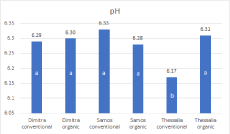
Figure 1: Estimation of lentil cultivars’ pH values in both conventional and
organic farming systems.
The values of seed density ranged from 1.21g/ml for ‘Thessalia’ cultivar to 1.56g/ml for ‘Dimitra’ cultivar. Seed density after 24-hour hydration (g/ml) between cultivars showed statistically significant differences and ranged from 1.09% in the cv. ‘Thessalia’ to 1.15g/ml in cv. ‘Samos’.
Hydration and absorption coefficients were estimated after keeping the seeds in water for 24 hours and showed statistically significant differences between cultivars. The hydration coefficient ranged from 2.16 (cv. ‘Thessalia’) to 2.28 in cv. ‘Dimitra’. The lowest value of absorption coefficient is presented in cv. ‘Thessalia’ (2.39) and the highest in cv. ‘Dimitra’ (2.51).
Principal component analysis was carried out to describe the distribution of the accessions studied, taking into account the physicochemical properties of the three lentil cultivars in the two farming systems. Figure 2 diagram show that characteristic “seed density” was positioned with ‘Dimitra’ cultivar. The conventional farming system was positioned with ‘Thessalia’ cultivar and pH value with cv. ‘Samos’. The organic farming system is related to hydration and absorption coefficients and seed density after hydration for 24 hours. The final observation indicates that organic culture supports the better culinary properties of lentil, especially in cultivars like ‘Samos’ and ‘Dimitra’.

Figure 2: Principal component analysis’ diagram, as for physicochemical
characteristics and lentil cultivars, in conventional and organic farming
systems.
The diagram of Principal Component Analysis presented in Figure 3, explains 60.88% of the total variability. Specifically, physicochemical properties were divided into three groups. Hydration coefficient and density after 24h of hydration for both farming systems, together with the pH values in conventional farming systems, synthesize the first group. The second group includes seed density and hydration coefficient of both two farming systems. pH value of seeds derived from the organic farming system is positioned on the left part of Figure 3, far from all the other accessions.

Figure 3: Principal component analysis’ diagram, as for physicochemical
characteristics of lentil cultivars, in conventional and organic farming systems
Principal Component Analysis’ diagram in Figure 4, made for all the cultivars in the two farming systems, explains 65.75% of the total variation. Cultivars are separated in two groups. The first group includes cv. ‘Samos’, cv. ‘Dimitra’ and cv. ‘Thessalia’ when cultivated in the organic farming system and cv. ‘Samos’ from the conventional farming system. ‘Dimitra’ and ‘Thessalia’ cultivars of conventional farming systems are classified into a second group.
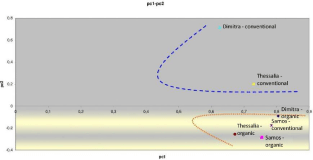
Figure 4: Principal component analysis’ diagram, as for lentil cultivars, in
conventional and organic farming systems.
After the chemical analysis, the mean content of macronutrients P, K, Ca and Mg for three lentil cultivars in the two environments of cultivation is presented in Figure 5. ‘Dimitra’ in organic farming conditions had higher levels of macronutrients than conventional farming. The mean content of phosphorus for all cultivars was 410mg/100g of lentil seed and ranged from 300mg in cv. ‘Samos’ in the organic farm to 580mg for cv. ‘Thessalia’ in the conventional farming system. The mean content of potassium for the three cultivars and the two farming systems was 900mg/100g and ranged from 750mg in cv. ‘Samos’ at the conventional farm to 1070mg in cv. ‘Thessalia’, when cultivated in the organic farming system.
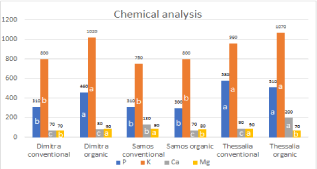
Figure 5: Chemical analysis (P, K, Ca, Mg) of lentil cultivars (mg/100g) in
both conventional and organic farming systems.
Calcium content in lentil seeds ranged from 70mg/100g in cv. ‘Dimitra’ and 72mg in cv. ‘Samos’ for the conventional and organic farming systems respectively, to 200mg in cv. ‘Thessalia’ collected from the organic farming system. Magnesium content ranged from 70mg in cv. ‘Dimitra’ to 90mg in cv. ‘Thessalia’ at the conventional farming system.
Concentration of Fe, an important micronutrient in lentil, shows significant differences among cultivars as well as between the two environments of cultivation. The three cultivars in two environments had a mean concentration of Fe 10.21mg/100g ranging from 5.7mg/100g (‘Thessalia’ organic farming system) to 15.4mg/100g (‘Dimitra’ organic farming system). A high level of Fe was also found in cv. ‘Samos’ which was collected from the conventional farm. Fe concentration in cv. ‘Samos’ from the conventional farm, was higher and differentiated significantly from lentil seeds originated from the organic farm. In cv. ‘Thessalia’ there were no significant differences between the two environments, but the content of Fe differed significantly from the other cultivars. The mean content of Zinc was 3.63mg/100g and ranged from 2.7mg/100g in ‘Samos’ cultivar in the conventional farming system to 4.9mg/100g in ‘Dimitra’ cultivar in the organic farm (Figure 6).
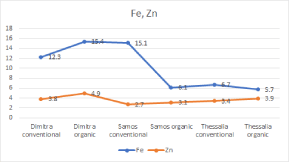
Figure 6: Chemical analysis (Fe, Zn) of lentil cultivars (mg/100g) in both
conventional and organic farming systems.
The mean content of Mn was 1.43mg/100g and ranged from 0.9mg/100g in cv. ‘Samos’ from the organic farming system to 2.3mg/100g in cv. ‘Dimitra’ which was collected from the organic farming system. The highest Boron content was 1.33mg in ‘Samos’ cultivar at the organic farming system and the lowest in ‘Thessalia’ at the conventional farming system (0.43mg/100g) (Figure 7).
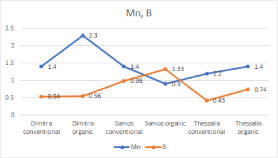
Figure 7: Chemical analysis (Mn, B) of lentil cultivars (mg/100g) in both
conventional and organic farming systems.
In Figure 8 and 9 are presented the relative concentration of nutrient elements per 100gr (one plate), as estimated with regards to the Recommended Dietary Allowance (RDA): the average level of daily dietary intake which is sufficient to meet nutrient requirements of 97– 98 percent of healthy persons in particular life stages and gender groups.

Figure 8: The percentage that is covered by a plate (100g) of each lentil
cultivar, in both conventional and organic systems, compared with the
recommended daily intake (P: 700mg/day, K: 2450mg/day, Ca: 200mg/day,
Mg: 320mg/day).
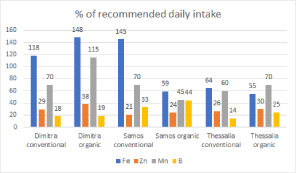
Figure 9: The percentage that is covered by a plate (100g) of each lentil
cultivar, in both conventional and organic systems, compared with the
recommended daily intake (Fe: 10.4mg/day, Zn: 13mg/day, Mn: 2mg/day, B:
3mg/day).
Macro- and micronutrient elements of lentil in this study cover a high percentage of human’s daily requirements. Lentil seeds derived from ‘Dimitra’ cultivar in the organic farming system provide a higher percentage of all macronutrients and micronutrients than the conventional farming system. As concerns to ‘Samos’ cultivar there are no significant differences in the percentage of P, K, Ca and Mg between the two farming systems. Also, the percentages of Fe and Mn are higher in the conventional farming system, with Fe exceeding the RDA. Lentil seeds of ‘Thessalia’ cultivar provide a high percentage of P in conventional (83%) and organic (73%) farming systems. Percentages of Zn and B are higher in the organic farming system for all the lentil cultivars used. Overall, identifying genotypes that could produce seeds with high micro- and macronutrient contents could promote the adoption of lentil crop for biofortification and reduce malnutrition in developing countries where lower inputs are usually used [18].
Conclusion
Based on the results of the physicochemical properties and the chemical analysis for the three cultivars under the two farming systems, several conclusions could be drawn. For all cultivars, the organic environment significantly increased the potassium and zinc concentration in seeds. Furthermore, the organic farming system improved the nutrient concentration for the cultivar ‘Dimitra’, while ‘Samos’ exhibited a slightly better performance under conventional conditions. On the contrary, highest Fe values were estimated for ‘Samos’ and ‘Thessalia’ in conventional conditions. Boron content in all cultivars was slightly (e.g. ‘Dimitra’) or significantly better (e.g. ‘Samos’ and ‘Thessalia’) under organic cultivation practices. On the other hand, Mn was increased for ‘Dimitra’ and ‘Thessalia’ when cultivated in an organic environment. The opposite trend was calculated for the cultivar ‘Samos’.
When the recommended daily intake percentage is estimated for the nutrients P, K, Ca and Mg based on the Recommended Dietary Allowance, it is clear that the cv. ‘Thessalia’, especially when organic farming is applied, is the best choice followed by cv. ‘Dimitra’. Similar results have been estimated for the nutrients Fe, Zn, Mn and B. In this case, the cv. ‘Dimitra’ under both cultivating systems and ‘Samos’ under conventional conditions covered a high percentage of the recommended daily requirements.
In conclusion, the selection of the appropriate cultivar is an important factor that should be carefully considered when lentil is cultivated in an organic or a conventional farming system, since it could influence the nutritional value and physicochemical sensory properties as related to daily human coverage.
References
- Kumar S, Barpete S, Kumar J, Gupta P, Sarker A. Global Lentil Production: Constraints and Strategies. SATSA Mukhapatra-Annual Technical Issue. 2013; 17: 1-13.
- Srivastava RP, Vasishtha H. Dietary Fiber, Protein and Lectin Contents of Lentils (Lens culinaris) on Soaking and Cooking. Current Advantages in Agricultural Sciences. 2013; 5: 238-241.
- Erskine W, Sarker A, Kumar S. Lentil: Breeding. Wrigley C, Corke H, Seetharaman K, Faubion J, editors. In: Encyclopedia of Food Grains. Academic Press. 2016; 4: 317-324.
- Vandemark GJ, Grusak MA, McGee RJ. Mineral Concentrations of Chickpea and Lentil Cultivars and Breeding Lines Grown in the U.S. Pacific Northwest. The Crop Journal. 2018; 6: 253-262.
- Thavarajah D, Thavarajah P, Wejesuriya A, Rutzke M, Glahn RP, Combs Jr GF, et al. The Potential of Lentil (Lens culinaris L.) as a Whole Food for Increased Selenium, Iron, and Zinc Intake: Preliminary Results from a 3 Year Study. Euphytica. 2011; 180: 123-128.
- Thavarajah D, Thavarajah P, Sarker A, Vandeberg A. Lentils (Lens culinaris medikus subspecies culinaris): A Whole Food for Increased Iron and Zinc Intake. J. Agric. Food Chem. 2009; 57: 5413-5419.
- Nwokolo E, Smartt J. Food and feed from legumes and oilseeds. 1st. edn. London: Chapman & Hall. 1996.
- Ninou E, Papathanasiou F, Vlachostergios DN, Mylonas I, Kargiotidou A, Pankou C, et al. Intense Breeding within Lentil Landraces for High-Yielding Pure Lines Sustained the Seed Quality Characteristics. Agriculture. 2019; 9: 175.
- Wang N, Hatcher DW, Toews R, Gawalko EJ. Influence of Cooking and Dehulling on Nutritional Composition of Several Varieties of Lentils (Lens culinaris) LWT - Food Science and Technology. 2009; 42: 842-848.
- Jarpa-Parra M. Lentil protein: A Review of Functional Properties and Food Application. An Overview of Lentil Protein Functionality. Int J. Food Sci. Technol. 2018; 53: 892-903.
- Joshi M, Timilsena Y, Adhikari B. Global Production, Processing and Utilization of Lentil: A Review. J Integr. Agric. 2017; 16: 2898-2913.
- Vlachostergios DN, Roupakias DG. Response to Conventional and Organic Environment of thirty-six Lentil (Lens culinaris Medik.) Varieties. Euphytica. 2008; 168: 449-457.
- Urbano G, Porres JM, Frías J, Vidal-Valverde C. Nutritional Value in Lentil. Yadav SS, McNeil D, Stevenson PC, editors. In: An Ancient Crop for Modern Times. Springer. 2007; 47-93.
- Tilman D, Clark M. Global Diets Link Environmental Sustainability and Human Health. Nature. 2014; 515: 518-522.
- Warne T, Ahmed S, Byker-Shanks C, Miller P. Sustainability Dimensions of a North American Lentil System in a Changing World. Front. Sustain. Food Syst. 2019; 3: 88.
- Carbonaro M, Nardini M, Maselli P, Nucara A. Chemico-Physical and Nutritional Properties of Traditional Legumes (Lentil, Lens culinaris L., and Grass Pea, Lathyrus sativus L.) from Organic Agriculture: An Explorative Study. Organic agriculture. 2015; 5: 179-187.
- Suliman MA, El Tinay AH, Elkhalifa AEO, Babiker EE, Elkhalil EAI. Solubility as Influenced by pH and NaCl Concentration and Functional Properties of Lentil Proteins Isolate. Pakistan Journal of Nutrition. 2006; 5: 589-593.
- Karaköy T, Erdem H, Baloch FS, Toklu F, Eker S, Kilian B, et al. Diversity of Macro-and Micronutrients in the Seeds of Lentil Landraces. The Scientific World Journal. 2012; 2012: 9.